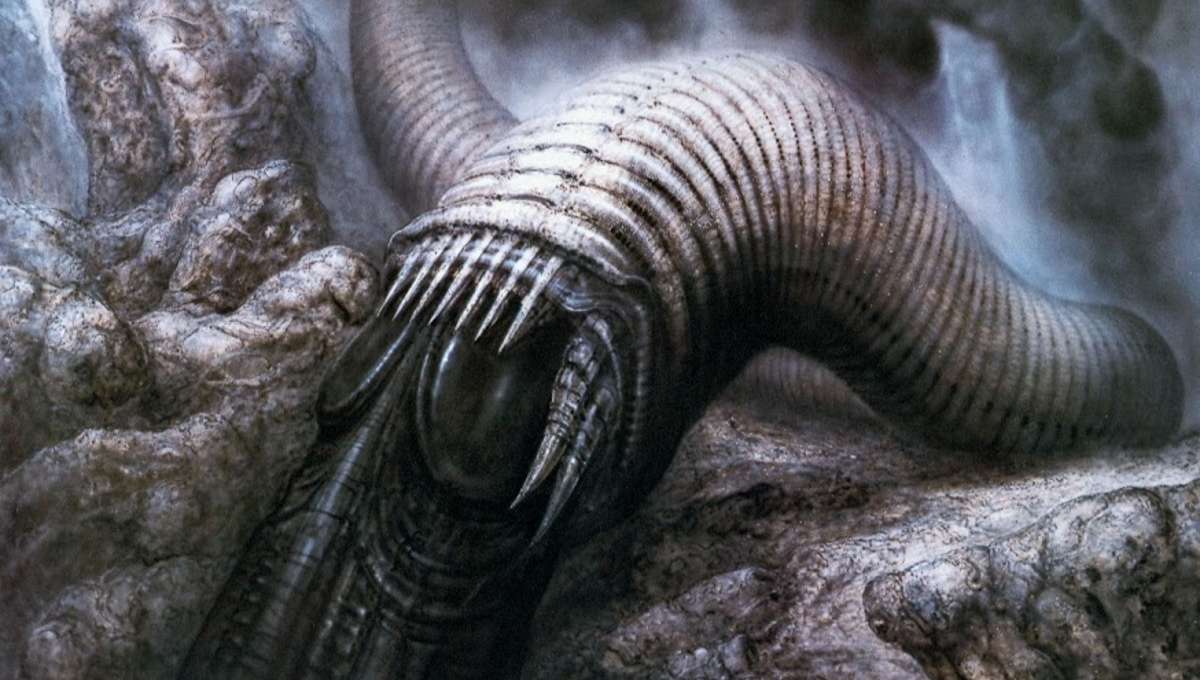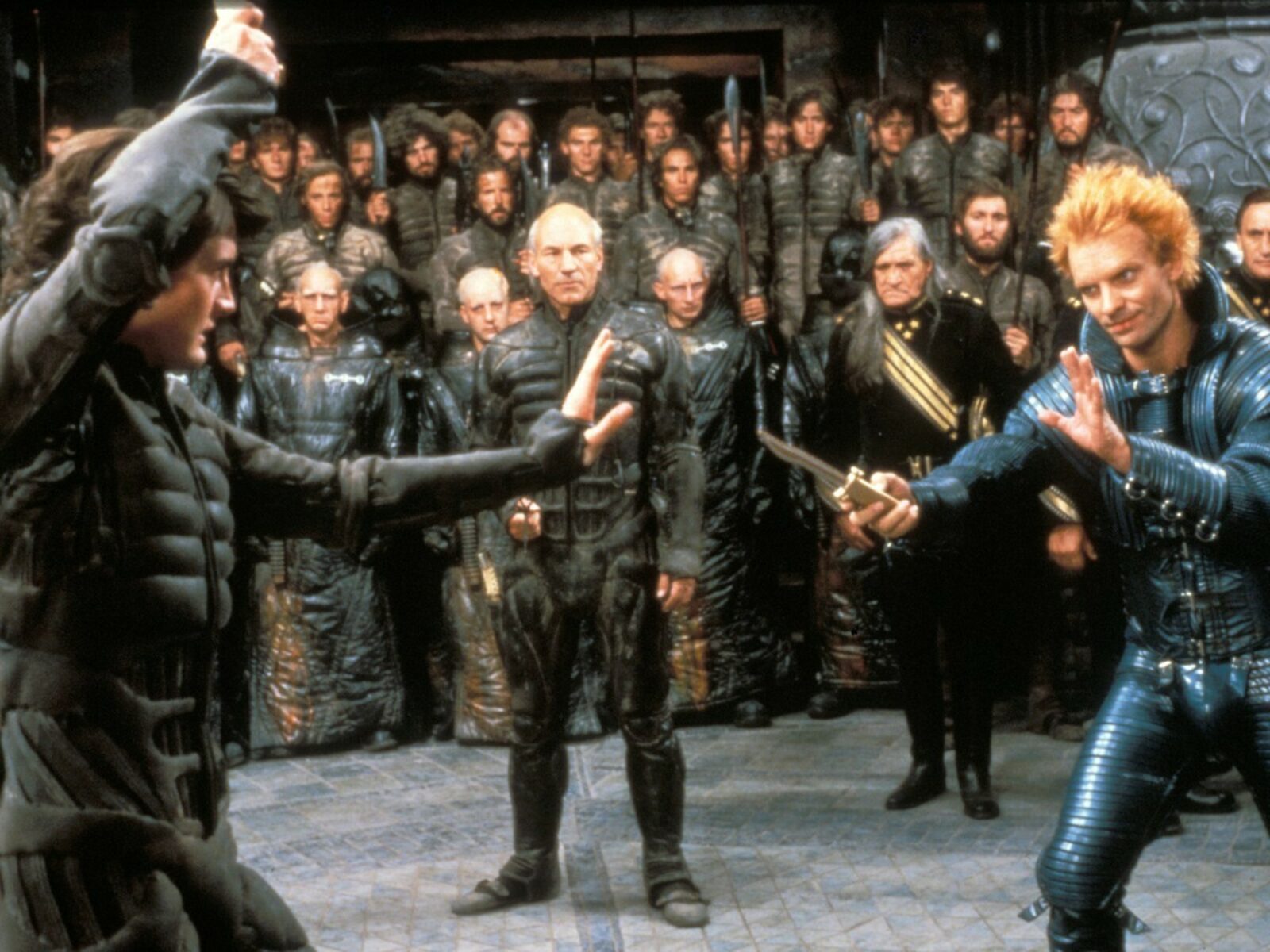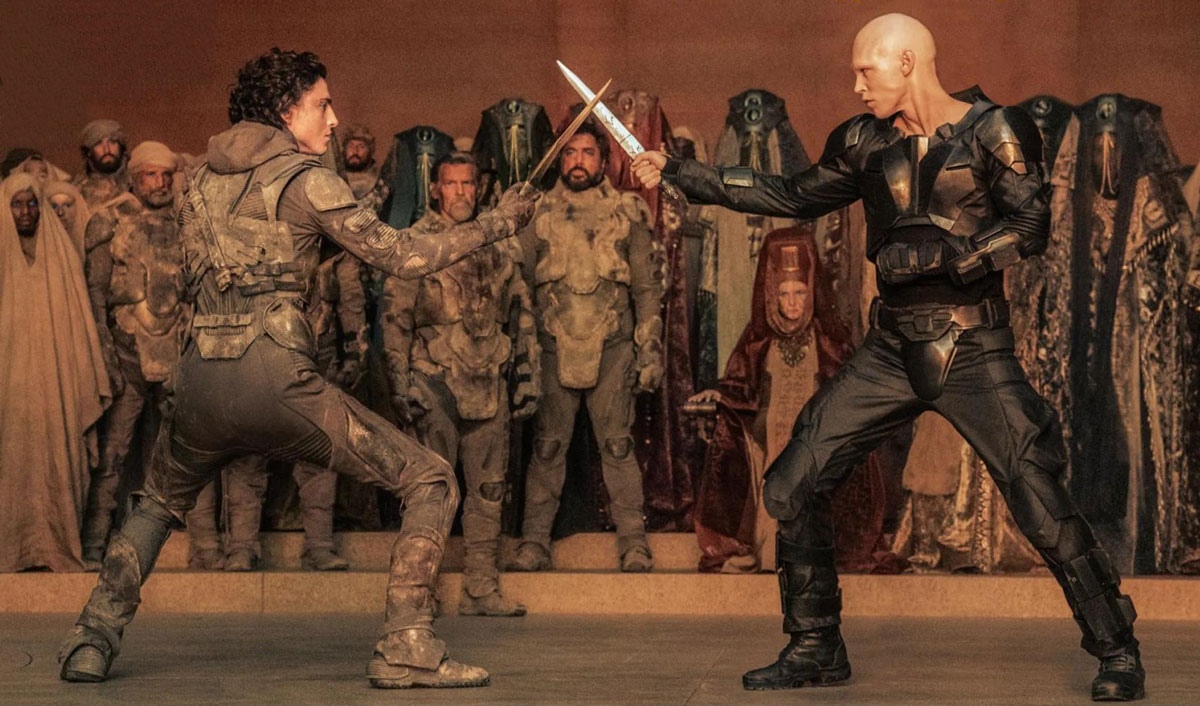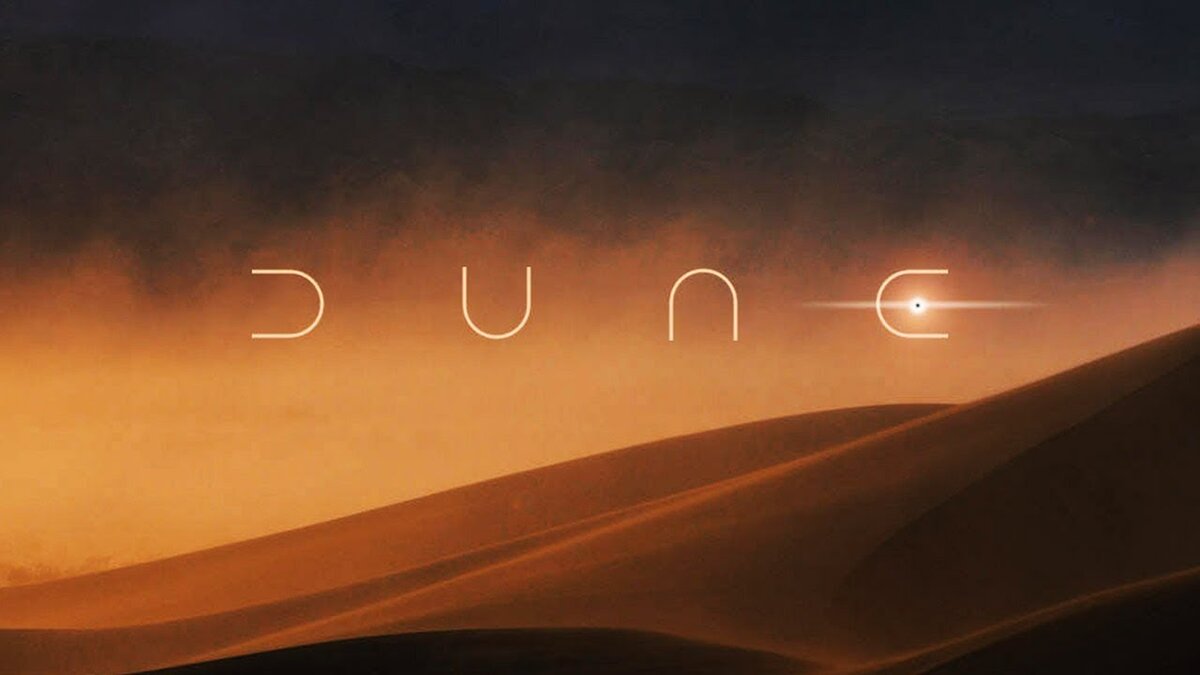Several top directors and designers tried valiantly to bring Dune to the screen. They failed, but their visions live on.
This Christmas. Dune will finally make it to the big screen But the elusive project took its time getting there, fumbling from one “visionary” to the next, leaving many skeptics wondering if Frank Herbert‘s classic could be filmed.
It started back in the late ’60s, nearly six years after Dune‘s publication. Producer Arthur P. Jacobs, responsible for the lucrative Planet of the Apes series, optioned Frank Herbert’s novel. But the producer’s unexpected heart attack and death stopped the production before it began.
Some seven years later. Chilean-born director Alejandro Jodorowsky entered the scene. An avant-garde stylist, Jodorowsky is best known for his El Topo, which took the underground and midnight movie circuit by storm in 1971. An excessive, quasi-mystical “religious western,” El Topo shocked with its violent, surreal imagery. Jodorowsky’s next feature. 1973’s little-seen The Holy Mountain, is considered even more bizarre.
Regardless of what one may think of Jodorowsky’s talents (or lack of discipline). he became a full-blown celebrity of the surreal. Then in 1975, it looked like Jodorowsky would really hit the big time: A wealthy Parisian eager to break into the film business, Michael Seydoux, agreed to provide backing for a Jodorowsky-directed Dune.
Dune could have been Jodorowsky’s big break—his chance to enjoy the luxuries of a huge budget; his ticket to mainstream respectability. But the director seemed to have other things on his mind, approaching the project spiritually, mystically.
“Dune is much more than a science-fiction novel.” said Jodorowsky. “It deals with themes like the creation of a Messiah, the ascension through different levels necessary to dominate over circumstances which are harmful to humankind.
“There are also the themes of a search for Eternity, for superior mental powers; drug addiction; and basically, of loneliness.” he continued. “It’s the story of a man who develops his mind enough to reach a summit, but once up on this summit, he has lost all human contact. Then to find human contact again, he has to try and bring all the human race up to where he is now. All the Messiahs we know, from Buddha to Christ had to face this question.
“As for Harkonnen [the evil, dark planet], I saw it as a vision of Contemporary Man. A vision of a world where nothing is sacred, where Man is born in a dustbin, where the whole world is garbage.”
With these thoughts in mind, Jodorowsky went to work—first, securing the rights to Herbert’s novel, then writing a screenplay, and ultimately setting up a Dune preproduction unit in Paris. He recruited an amazing group, including Chris Foss, a British artist who designed covers for many science fiction volumes; Jean “Moebius” Giraud, a French illustrator who produced work for Heavy Metal; H. R. Giger, a Swiss designer best known for his later Oscar-winning work on Alien; and famous surrealist Salvador Dali.
Giraud was already busy creating the film’s creatures and characters, when Jodorowsky discovered Foss. While researching science fiction designers to work on Dune, the director came across a book, 21st Century Foss, which featured Foss’ designs.
“Jodorowsky was absolutely thrilled with the book, and out of the blue, I got a phone call asking if I’d like to work on a film in Paris,” said Foss. “I was specifically brought in to work on the hardware. And I might add that there is not a lot of hardware in Dune, but by the time Jodorowsky and I had finished with it, there was certainly quite a bit of exotic machinery.”
With Foss and Giraud busy at work, Jodorowsky then hired neophyte filmmaker Dan O’Bannon to head the special effects. Jodorowsky originally sought Douglas Trumbull, but the two couldn’t come to terms, necessitating a new expert. O’Bannon was then whisked to Paris, and with a crew of 30 (including a Paris-based effects company named Eurocitel) spent six months on the project.
One of the last to jump on board was Giger. The Swiss artist first heard about Dune through Bob Venosa, an American painter who was a friend of Salvador Dali’s. Dali, who was to play the Emperor in Dune—for a reported salary of $100,000 an hour—met Giger, looked over his portfolio, and passed it on to Jodorowsky.
Impressed with what he saw, Jodorowsky asked Giger to join the group. Giger started designing Harkonnen Castle, using storyboards by Giraud.
The artists agree that Dune was an eye-opening experience—a chance for them to work freely, independently without studio interference. “I was allowed a flight of fancy,” said Foss. “It was a very personal film—Jodorowsky had taken quite a personal interpretation of the book—and we were all allowed, within his parameters, terrific leeway.”
In addition to personal and artistic freedom, the artists found that they had few, if any, budgetary restrictions.
‘‘No budgetary restrictions whatsoever!” insisted Foss. “It was a designer’s dream.”
But this dream quickly died. Just when the film was ready to roll—with the storyboards, designs and the script finished—Jodorowsky’s Dune began to take on the proportions of a mythic debacle. With a proposed budget of $9.5 million ($2 million of which had already been spent) and an eager crew ready to begin building props and sets, the project fell apart.
Dali and Jodorowsky reportedly began quarreling, momentum began to slow down, and with Seydoux’s abrupt withdrawal of financial support, the film went belly up.
Chris Foss picked up the story: “The company financing the Dune project was called Camera One [a French film production company]. The producer [Seydoux] and, I think, Jodorowsky went to Los Angeles shortly before the Christmas of 1975, with the hope of getting American interest in the film and setting up a co-production deal. I believe that there was a disagreement in Los Angeles about how the film should be made. Bearing in mind how large the budget had by then become, the French company was unable—or possibly unwilling—to finance it totally on its own.”
For the people who had spent many months developing the project, the demise of Dune came as a complete shock.
“Basically it [Dune] was a glorious experience, and then it was over” said O’Bannon in a 1977 interview for Phobos. “I was sent back to the States around Christmas of ’75 to try to find some special Vista Vision equipment, and while I was back there staying with friends, I got a telegram informing me that Dune was postponed indefinitely. And everything fell apart.’’
But O’Bannon quickly got back on his feet, churning out a script called Dune. The 20th Century-Fox science fiction shocker could have been dubbed “Dune Revisited.” with Foss, Giraud and Giger all contributing their talents.
Jodorowsky was not as lucky as O’Bannon and company. His next project Tusk, wasn’t nearly as big as Alien, getting limited distribution at best. But Jodorowsky isn’t at all disappointed, not at all angry that the creative team he put together went on to highly successful projects. He’s not bitter—and he refuses to call Dune a failure.
“Being an ardent adept of Karma Yoga, I am interested in the work I do, but not in the result of this work, whether good or bad,” said Jodorowsky. “So. I deeply enjoyed working on Dune, and for me, anyway, the film was made.”
But for a lot of people out there, it wasn’t. So, in 1978, three years after Jodorowsky let the film go, Italian mega-producer Dino DeLaurentiis jumped on the Dune bandwagon, buying up the rights. Going back to the original source, DeLaurentiis commissioned a Dune script from none other than Frank Herbert.
But the resulting 175-page scenario was ultimately deemed unacceptable. By most accounts. Herbert was simply too close to his original work and was unable to remove the necessary subplots and incidents which would have to be excised in order to arrive at a working script.
A man with more than 600 production credits to his name and 35 years in the business, DeLaurentiis refused to give up. In a P.M. Magazine interview televised in September 1983, DeLaurentiis said. “To make Dune, you must be crazy. And I believe I’m crazy enough, and have the courage enough, to do Dune.”
After dismissing Herbert and rereading the original novel three more times, DeLaurentiis was convinced more than ever that the book was filmable. This time, however, DeLaurentiis took a different tack: he would pick a highly visual director for the project and then find the proper Dune scriptwriter.
In late 1979, DeLaurentiis hired Ridley Scott, who was fresh from his success with Alien. Scott established a base shop at England’s Pinewood Studios and selected his ex-Alien alumnus H. R. Giger, returning to the Dune project as the production designer. Both men immediately began turning out storyboards and drawings to illustrate the film.
With the apparent rebirth of the project under way. Scott then hired Rudolph Wurlitzer, a novelist whose two produced screenplays, Pat Garrett and Billy The Kid and Two Lane Blacktop, revealed intellectual and minimalist inclinations. But even with this talented scenarist on board, the Dune script, once again, was a key stumbling block.
“The Dune adaptation was one of the most difficult jobs I ever did.” said Wurlitzer. “I did three drafts of that script before I was even beginning to become satisfied with its structure. Even then the initial result was more of a working outline than a script. But eight months later I felt Ridley [Scott] and I had a very strong working screenplay of Dune that, at the very least, kept true to the spirit of the novel. I will say, however, that we rarified it, and injected a different sensibility into the script than that of the book’s.”
In other words, they changed it. For example, Wurlitzer and Scott apparently softened several characters. Paul Atreides, Herbert’s central character who becomes a galactic Messiah, is more mercurial, more the political leader—and much more ambiguous.
Wurlitzer and Scott’s description of the Fremen (the desert nomads who are the secret rulers of Arrakis/Dune) retains their blue within blue eyes (the result of spice addiction, a trait described in the book), but, at least in the early portions of this screenplay, their original ferocity was diluted. Herbert’s ultimate heavy, the Baron Harkonnen, was also toned down.
But it was in the first draft of Wurlitzer’s Dune script that the greatest, and most controversial, alteration of Herbert’s book took place. “I took what I always felt to be a latent but very strong Oedipal attraction between Paul and the Lady Jessica, his mother, one step further.” Wurlitzer said. “I injected a lovemaking sequence between these two. I meant that act as a supreme defiance of certain boundaries, which might make Paul even more heroic—in the sense that he willingly, but lovingly, broke a taboo.”
As a result of this scene, Alia, the strange woman-child born with the mental capacity of an adult, becomes Paul’s sister and daughter.
But Herbert was less than pleased. The incest scene between Paul and Jessica was subsequently dropped in Wurlitzer’s succeeding drafts.
Although the slow development of a suitable script delayed the project, it was actually Ridley Scott’s projected budget of $50 million that took the life out of Dune. Although reaction to Wurlitzer’s script and Scott’s involvement had been generally favorable, a $50 million Dune (at the time) seemed excessive. (Ironically, the price tag of David Lynch’s Dune, with all production, advertising and ancillary costs added up, may exceed $75 million, making it one of the most expensive films of all time.)
By September of 1980 the final judgment was passed down—no go! Scott went on to Blade Runner, and the third attempt to film Dune was terminated.
Yet Dino DeLaurentiis continued to be bullish on Dune. “When we had our initial budget on Dune,” DeLaurentiis explained on that same P.M. Magazine broadcast, “it was so big that many people told me. ‘Oh. forget Dune!’ But I said, “No, no forget Dune! Let’s find the solution. When I believe in something I never give up.”
Paul M. Sammon, Stephen Jones, Frederic Albert Levy
Cinefantastique, September 1984





